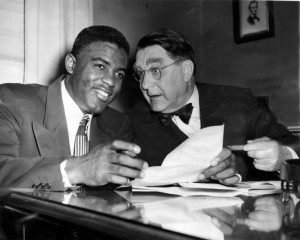Jackie Robinson: Faith in Himself – and in God
Weekly Editorial — Posted on April 17, 2014

Jackie Robinson and Branch Rickey.
(by Chris Lamb, The Wall Street Journal) – Brooklyn Dodgers President Branch Rickey first met Jackie Robinson on Aug. 28, 1945. Rickey told Robinson that he wanted to sign the 26-year-old ballplayer and break the national pastime’s color barrier. But for him to succeed, Rickey said, Robinson couldn’t respond to the indignities that would be piled on him: “I’m looking for a ballplayer with guts enough not to fight back.”
Rickey then opened a book published in the 1920s, Giovanni Papini’s “Life of Christ,” and read Jesus’ words: “But whoever shall smite thee on the cheek, turn to him the other also.” Robinson knew the Gospel and knew what was required of him. He replied, “I have two cheeks, Mr. Rickey. Is that it?” This meeting between the two Methodists, Rickey and Robinson, ultimately transformed baseball and America itself. …
What is often overlooked in accounts of Robinson’s life is that it is also a religious story. His faith in God, as he often attested, carried him through the torment and abuse of integrating the major leagues.
Robinson grew up in Pasadena, Calif., where his mother, Mallie, instilled in her five children the belief that God would take care of them. “I never stopped believing that,” Robinson later said.
It took awhile for Robinson as a young man to understand what that faith in God meant. He was involved in more than one fight, and scrapes with the law, prompted by racial antagonism. Arnold Rampersad, in his 1997 Robinson biography, describes how the teenager was rescued from the streets by the Rev. Karl Downs, the minister of Scott United Methodist Church in Pasadena. Downs became a father figure to Robinson and brought him back into the church. …
After serving in the U.S. Army during World War II, Robinson, who had been a stand-out athlete at UCLA, signed up in the spring of 1945 to play baseball for the Kansas City Monarchs in the Negro Leagues. Robinson openly scorned his whiskey-drinking and promiscuous teammates, once tossing a glass of scotch into a lighted fireplace to demonstrate how lethal liquor is. He also stunned his teammates by declaring that he was waiting until he was married to have sex.
As influential as Rev. Downs had been, though, no one had a more profound impact on Robinson’s life than Branch Rickey, whose religious devotion was such that he didn’t attend baseball games on Sundays. During their first meeting, after Rickey had read aloud the passage from Papini’s “Life of Christ,” he also asked Robinson to read from the section about “nonresistance.” Robinson understood what was needed for him to succeed.
Nobody in sports had ever faced the sort of pressure, and abuse, that Jackie Robinson did when he took the field for the first time in a Brooklyn uniform on April 15, 1947. And yet Robinson didn’t merely endure, he thrived.
In a 1950 newspaper interview, he emphasized his faith in God and his nightly ritual of kneeling at bedside to pray. “It’s the best way to get closer to God,” Robinson said, and then the second baseman added with a smile, “and a hard-hit ground ball.”
After Robinson retired from baseball, he wrote newspaper columns for the New York Post and the Amsterdam News in New York. Many of the columns are collected in a new book, “Beyond Home Plate,” edited by Michael G. Long. Writing for the Post in 1960, Robinson compared his own experience with “turning the other cheek” with the nonviolent confrontation of the civil-rights movement espoused by his friend, Martin Luther King Jr.
“I can testify to the fact that it was a lot harder to turn the other cheek and refuse to fight back than it would have been to exercise a normal reaction,” Robinson wrote. “But it works, because sooner or later it brings a sense of shame to those who attack you. And that sense of shame is often the beginning of progress.”
Mr. Lamb, a journalism professor at Indiana University in Indianapolis, is the author of “Blackout: The Untold Story of Jackie Robinson’s First Spring Training” (University of Nebraska, 2004).
Published April 11, 2013 at The Wall Street Journal. Reprinted here April 17, 2014 for educational purposes only. Visit the website at wsj .com.
